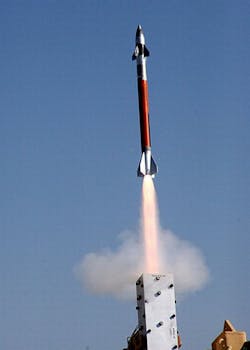Army asks Lockheed Martin to push forward with developing counter-mortar and artillery missile
Officials of the Army Contracting Command at Redstone Arsenal, Ala., announced their intention on Friday to award a five-year follow-on contract to the Lockheed Martin Corp. Missiles and Fire Control segment in Grand Prairie, Texas, for the Extended Area Protection and Survivability (EAPS) Integrated Demonstration (ID) program.
Lockheed Martin (NYSE:LMT) won an Army contract in 2010 to support the Army's EAPS ID program to develop enabling technologies for advanced counter rocket, artillery, and mortar (C-RAM) capability.
Over the past four years Lockheed Martin has been developing an affordable, agile, hit-to-kill interceptor rocket for the EAPS program that is less than three feet long, about two inches in diameter and weighs less than 10 pounds at launch. Lockheed Martin engineers are aiming at an Army cost target of $16,000 per round.
The Lockheed Martin EAPS interceptor has a high frequency fire control sensor, and a hit-to- kill interceptor that can destroy incoming rockets, artillery, and mortar rounds at tactically significant ranges, company officials say.
Related: Lockheed Martin EAPS performs controlled flight test
Two years ago Lockheed Martin flight-tested an EAPS ID rocket at White Sands Missile Range, N.M. During the flight test, the tactically configured miniature hit-to-kill (MHTK) interceptor was launched vertically and then performed a series of maneuvers to demonstrate required performance while capturing data. Additional EAPS ID tests were conducted later in 2012.
Now Army researchers want Lockheed Martin to build a functional EAPS ID unit called the EAPS Battle Unit to demonstrate the system's ability to shoot down rockets, artillery, and mortar rounds before the incoming munitions can do damage.
The Army is proposing a five-year follow-on contract that would extend through fall 2019 to complete EAPS ID development. The value of the upcoming contract has yet to be negotiated.
Related: Boeing to use 10-kilowatt, high-energy laser weapon to counter rockets and mortars
The Army Contracting Command will award the follow-on contract to Lockheed Martin on behalf of the Army Aviation and Missile Research, Development and Engineering Center (AMRDEC), Weapons Development, and Integration Directorate (WDID) at Redstone Arsenal, Ala.
Lockheed Martin is the only known company able to provide EAPS ID technology, and no other company is known to be able to perform the unique design, development, integration, and test requirements required under this acquisition, Army officials say.
For more information contact Lockheed Martin Missiles and Fire Control online at www.lockheedmartin.com/us/mfc, the Army Aviation and Missile Research, Development and Engineering Center at www.amrdec.army.mil/amrdec, or the Army Contracting Command-Redstone at www.acc.army.mil/contractingcenters/acc-rsa.
